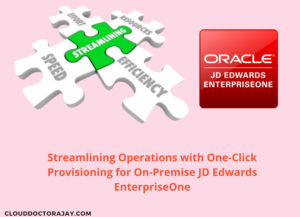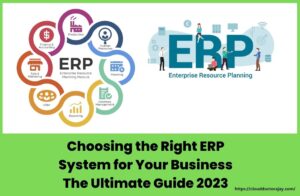Introduction To JDE E1
A comprehensive set of enterprise resource planning software called JD Edwards EnterpriseOne (JDE E1) enables businesses to optimize their processes and increase productivity. Upgrading the JDE E1 system becomes important over time as technology develops and business requirements change in order to stay current and benefit from the newest features and improvements.
In this blog post, we’ll examine the essential procedures for organizing and carrying out JDE E1 updates for a smooth transition.

1. Specifying Upgrade Goals
Setting defined objectives is essential before starting any improvement endeavour. Establish the upgrade’s goal, such as boosting system performance, enhancing functionality, or adhering to regulatory requirements. Having a clear understanding of the objectives will help to direct planning and decision-making throughout the upgrade process.
2. Assessing the Present Environment
Analyse the current JDE E1 environment in-depth to find any potential hazards or difficulties. Conduct a thorough system audit to assess the compatibility of the hardware, software, and database. The upgrade will be in line with the current IT framework thanks to this assessment’s assistance in identifying any necessary infrastructure adjustments.
3. Getting Both Internal and External Stakeholders Involved
JDE E1 upgrade is not a one-person task. IT teams, business users, consultants, and software providers must work together and coordinate with other internal and external stakeholders. To ensure a successful update process, involve these stakeholders right away. To keep everyone informed and involved, build a project team, assign roles and tasks, and establish frequent communication channels.
4. Making a Robust Upgrade Plan
A successful implementation depends on a clearly stated upgrading plan. Set manageable timeframes and milestones for each phase of the upgrade process. Think about things like data migration, system downtime, testing, and training. Consult with knowledgeable JDE E1 partners or consultants to create a thorough plan that covers all important parts of the upgrading.
Exploring Azure Kubernetes Service and Azure Container Instances for AI Model Deployment
5. Testing and Quality Control
It is essential to do extensive testing and quality assurance prior to launching the improved JDE E1 system. To ensure that existing customizations, configurations, and third-party programs work with the new version, create a test environment.
To make sure that all modules and processes are operating as intended, conduct functional, performance, and regression testing. When testing a system, think about include end users to verify functionality and get their comments.
6. Migration and Validation of Data
A crucial stage in JDE E1 upgrades is data migration. Before beginning the process, create a data migration strategy and make sure that all current data is correctly backed up. Throughout the migration process, check the correctness and integrity of the data to prevent any potential problems after the update. Create a rollback strategy in case unforeseen data problems appear during or after the update.
7. Change management and training
For a JDE E1 upgrade to be effective, thorough end-user training is essential. Create training materials and hold webinars or workshops to introduce users to the new features and functionalities of the upgraded system. Effective change management communication and activities are also necessary to guarantee that users accept the upgrade and adjust to the changes without any difficulty.
8. Post-Upgrade Monitoring and Support
Once the improved JDE E1 system is operational, pay close attention to how it performs and take immediate action to resolve any problems. Give end users ongoing assistance and respond to any questions or problems they may have. Review user comments and system performance frequently to find areas that could use improvement or more optimization.
JDE E1 Backup and Recovery Strategies: Ensuring Data Security and Business Continuity
Conclusion:
Planning meticulously, working together, and using a disciplined strategy are essential for carrying out JDE E1 improvements. Organizations can successfully navigate the upgrade journey and enjoy the advantages of an updated and optimized JDE E1 system by defining objectives, assessing the current environment, involving stakeholders, developing a robust plan, conducting thorough testing, ensuring smooth data migration, providing training and change management, and offering post-upgrade support.
Keep in mind that upgrading JDE E1 is a continuous process. The needs of businesses change as technology progresses. Therefore, in order to fully utilize the JDE E1 system and maintain their position at the forefront of innovation, businesses must be proactive and plan for upcoming improvements.




